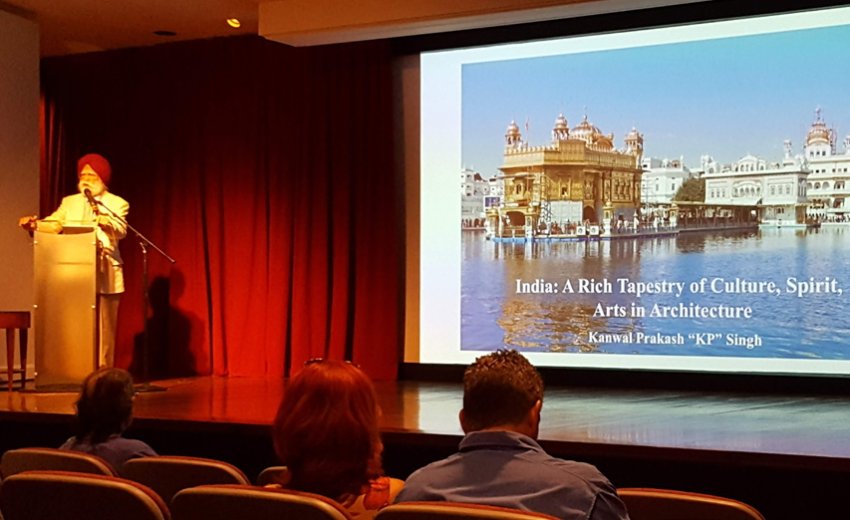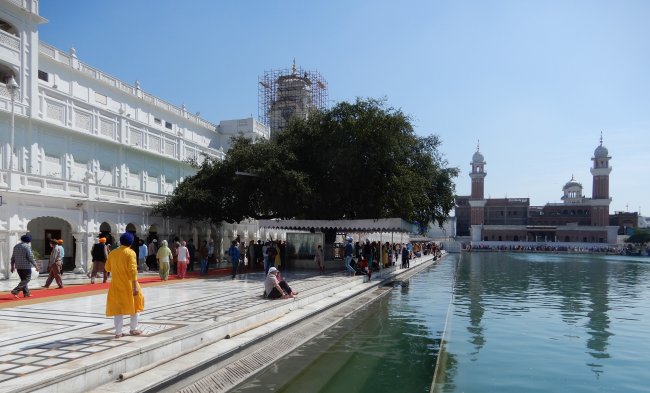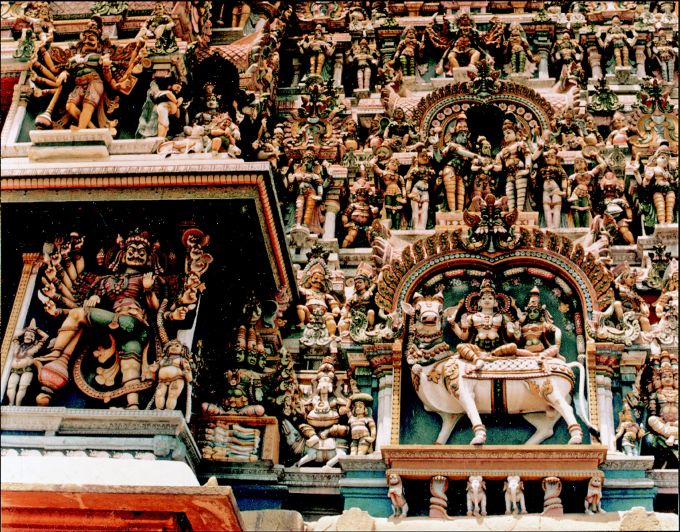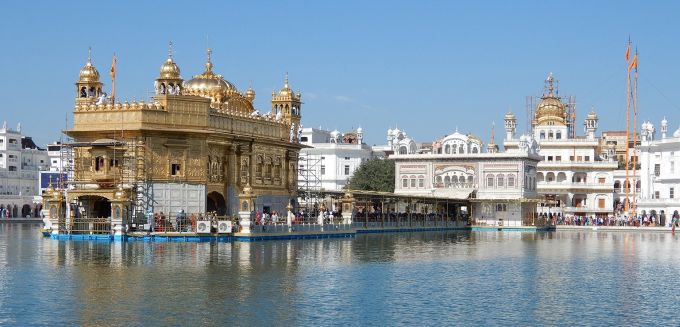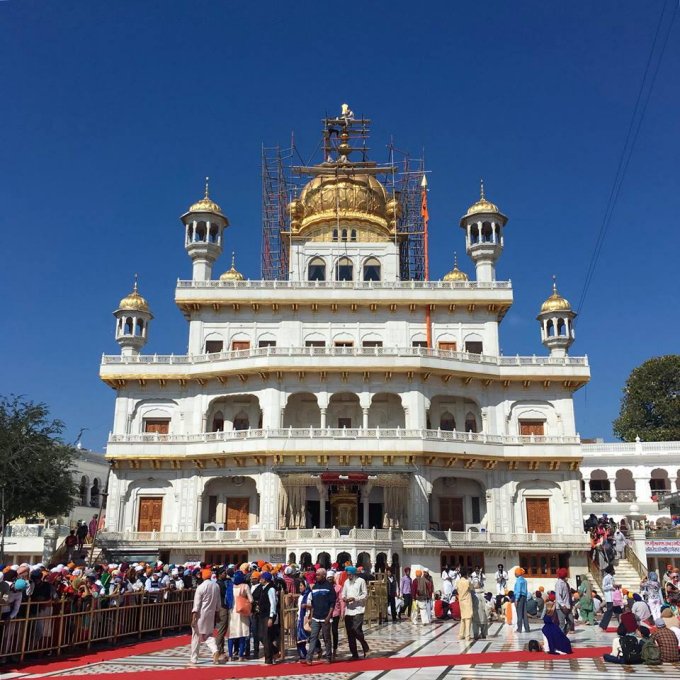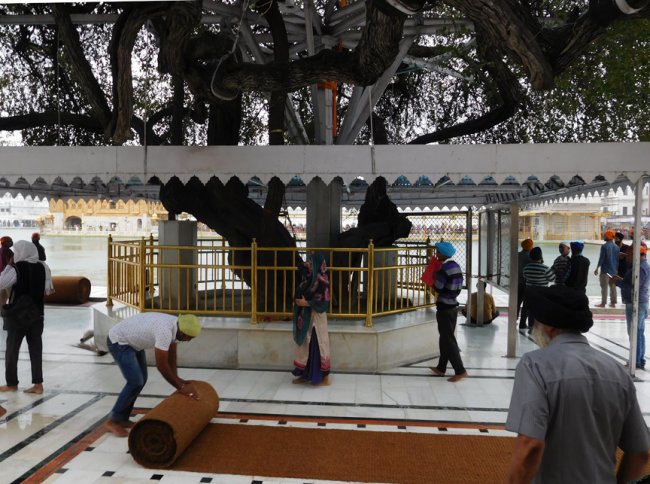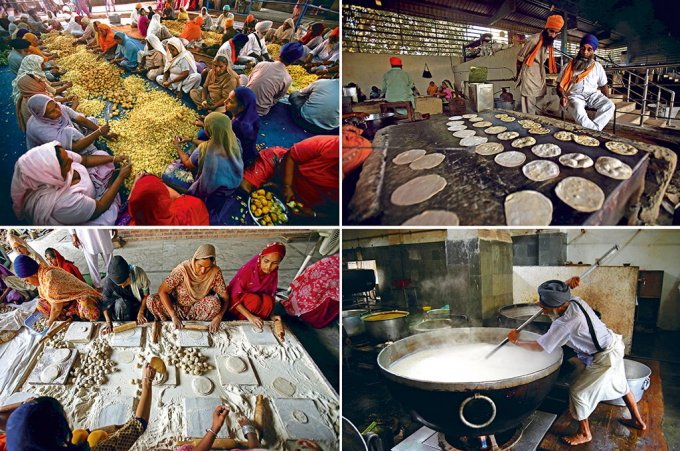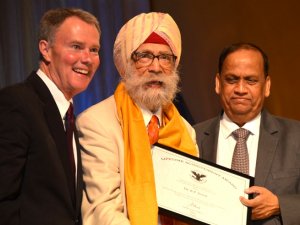India is a land with a variety of geographical landscapes and climatic zones;
Awesome natural wonders and a rich variety of flora and fauna; man-made creations;
An ancient civilization that is home of many diverse anthropological and racial textures;
Indian subcontinent - birthplace of Indus Valley Civilization, one of the oldest with many innovative firsts;
Birthplace of world religions - Hinduism, Buddhism, Jainism, and Sikhism;
India is also home to Christianity, Islam, Baha’i, Jewish, Zoroastrian faiths; other traditions and practices;
Over the centuries, India has attracted traders from other lands; hordes of invaders, rulers, and occupants - Aryans, Greeks, Persians, Moghuls, Mongols, British, French, Portuguese, and so many others.
Editor's note: The following is a presentation sponsored by the Asian Art Society in the Indianapolis Museum of Art. KP Singh says, "It was a great privilege to introduce
the magnificence and splendor of Harmander Sahib to the Hoosier audience."
-----
Today, the world’s largest democracy with over one billion people, represents a cross-section of humanity in an area 3/5 the size of United States of America. India is a rich tapestry of diverse faiths and cultural heritage, where the ancient, composite, and intersecting influences coexist and are reflected in India’s rich arts and architecture: ancient Ajanta and Ellora caves with rock-cut temples and frescoes; majestic South Indian Temples (at Thanjavur, Madurai, Belur); Buddhist Viharas, Stupas (Sanchi); Medieval Hindu Temples (at Konark, Khujaraho); Moghul monuments (Taj Mahal, Forts, Mosques); impressive Victorian buildings (Victoria Museum, Mumbai Railway Station, Rashtrapati Bhavan); and major world heritage sites. We see India’s richness in fabulous cultures: colorful festivals, films and fashions; in enchanting sights and sounds, music and dance, myths and mythology; in time-honored traditions and daring leaps into new ideas and innovative adaptations. India remains fiercely competitive, creating its own cultural waves and setting new global trends.
Enjoy some visual images that provide a glimpse of the arts, famous architecture, and cultures. They symbolize rich diversity, enchanting beauty, and enigmatic spirit of India.
Outside influences impacted the architecture, arts, culture, and spirit of India. In recent centuries, we saw reflections and emergence of Indo-Saracenic architecture - a synthesis of Hindu, Islamic, and Western styles in the Indian architecture. We see adaptation and delightful refinement of the Muslim and Hindu (Rajput) design elements, artistic style and treatment in Sikh sacred architecture and buildings.
Some of the generally-ascribed features of Indo-Saracenic architecture include:
One of the finest example of the adaptation and delightful refinement of many Indo-Saracenic architectural, design, and artistic elements are seen in The Golden Temple at Amritsar, India.
Our spotlight this afternoon is on Harmander Sahib (Temple of God) of the Sikhs. Popularly known as The Golden Temple, Harmander Sahib is a major attraction on the Indian Subcontinent and is located in the once-walled historic Sikh Holy City of Amritsar in the State of Punjab.
Sikh faith, the fifth largest religion in the world, claims nearly 35 million followers worldwide. Some estimates suggest that there are a million Sikhs in America; nearly 10,000 Sikhs that call Indiana home.
Harmander Sahib, the holiest shrine of Sikh faith, is the St. Peter’s and Western Wall of Sikhism. Harmander Sahib enshrines historic memorials and markers along a wide marble processional promenade with a colonnaded arcade surrounding a 1,500 feet square sacred pool. The Complex includes - The Akal Takht (Throne of Almighty); a Sikh Museum, Langar Hall (community kitchen), Residences for pilgrims and related facilities. The Golden Temple is a designated UNESCO World Heritage Site.
Harmander Sahib, the crown jewel of the Complex, has four entrances, one on each side, symbolizing that God is Omnipresent and the doors of this and other Sikh shrines are open to all. The Sikh faith affirms the central tenet that, “…We are Children of One God;” and the “…human family is One Brotherhood, One Race;” and all living beings are worthy of respect, dignity, equality and justice. All forms of discrimination against fellow beings based on caste, creed, gender, or station in life are an affront to God, to unifying spiritual lessons, to our common origin and shared humanity.
An overview of the magnificent Temple Complex and environs
Also known as Darbar Sahib (Court of the Lord) is like a gilded jewel radiating in its majestic splendor that appears to have descended from above and placed as a celestial spiritual throne, open and welcoming to everyone, in the midst of a large reflecting sacred lake-in-blue.
Harmander Sahib is one of most frequently visited sacred sites in the Indian Subcontinent, perhaps in the world, with over 100,000 pilgrims and visitors of every faith, culture, and tradition from around the world coming to pay homage and learn about Sikh faith each day. On high holy days, special occasions and celebrations at Harmander Sahib, that number may swell to 250,000 to 500,000 or more in a single day.
Harmander Sahib has been popularly known as The Golden Temple since the time of Sikh Maharaja Ranjit Singh, the celebrated Ruler of the Punjab, who at the beginning of nineteenth century renovated the shrine; embellished and adorned the walls, richly-sculpted windows, central dome and smaller domes, corner cupolas, ceilings of the shrine with embossed gilded plates, marble façades with exquisite inlays of precious and semiprecious stones, colored cut-glass, mirrors, gold filigree; columns with frescoes in brilliant colors; sculpted arches with panels of sacred text-in-gold and encased in interwoven designs.
Across the Darshini Deorhi, main entrance gateway to beautiful Harmander Sahib, stands the six-storey Akal Takht Sahib, the highest seat of Sikh spiritual and temporal authority since the seventeenth century; the time of the Sixth Sikh Guru, Hargobind Sahib. The Akal Takht and surrounding courtyard area rich with tradition and history; the Holy Scripture is ceremoniously brought here at night and taken in a joyous processional early each morning back to Harmander Sahib to offer blessings to all visitors.
The ornate Darshani Deorhi offers the pilgrims the first up-close glimpse of majestic shrine located in the middle of the Amritsrovar (Pool of Immortality). A beautiful marble Causeway connects the Deorhi to the sacred Harmander Sahib, the holiest sanctum of Sikh faith.
Once we cross the threshold, the scene before us represents a manifestation of spiritual grandeur and an aura of deep reverence, where the Sikh Holy Scripture, the Living Guru and Testament of Sikh faith and spirituality, wrapped in silken robes and fresh flowers, is installed under a richly brocaded Chandoa (canopy) amidst a splendidly-embellished intimate space. For the faithful, this is a blessed moment to be face to face with their Living Eternal Guru, an answered prayer and cherished pilgrimage to seek Divine Grace. The emotion of being momentarily in this hallowed space cannot be put in words.
The pilgrims make offerings and pay obeisance to their Guru, listen to the Sikh Ragis (religious singers) offering Praise of God Almighty in melodious Ragas (patterns of music) with hymns that affirm sanctity of all faiths and welcome all sentient beings into a spiritual embrace from early morning to deep into the night. An endless stream of Sikh faithful and visitors in the thousands pay homage at this sacred place throughout the day. The daily Broadcasts transmitted live are reaching millions around the world.
Within the Harmander Sahib Complex, there is a Langar Hall (community Kitchen) where free Langar (vegetarian food) is prepared and served to 100,000 visitors each day. The tradition of serving free food in Sikh Gurdwaras began over 500 years and today they serve food daily to 50 million people worldwide.
Harmander Sahib is their heart and soul, the holiest of holy to the Sikhs: A place that has witnessed the sacrifices of countless to defend its honor and sanctity; reinforced their commitment to the sacred faith commandments: equality, justice, dignity of all God’s children, sanctity of all sacred traditions, and service of humanity.
In spirit and design, The Golden Temple exemplifies, when sacred architecture becomes a testimony of celestial grandeur, where each beautiful element and embellishment gives one pause to reflect upon matters of Spirit, splendor of Creation, and Veneration of Divine. This is a Sanctuary of Bliss for everyone who arrives here for prayer, with a petition, or a spirit to learn about the tradition of a major world religion. This magnificent edifice, the Golden Temple at Amritsar embodies all that and more as a world heritage treasure.
The DARBAR SAHIB of the SIKHS
Kanwal Prakash Singh
Magnificent setting, architecture, rich heritage proclaim the spirit; soul of a Faith;
Sacred Courtyard reverberating with music of Praise, Unity, and Humanity;
A welcome open invitation to a pilgrimage:
To a Sanctuary of Hope and Love, devotion and renewal.
Sikh Gurus, sacrifices and righteous defiance of martyrs nurtured its sanctity,
Prayers of countless millions of every faith, culture, national origin
Across the formidable frontiers and centuries,
Personifying the Spiritual Light manifest.
“A hallowed ground, a sacred edifice like none other”
That embodies Faith in One God; Love for all His Children;
This is the majestic Darbar Sahib of the Sikhs:
A Golden Throne for Almighty; a welcome place for everyone.
KPSinghDesigns.com August 4, 2018 Indianapolis, Indiana USA

